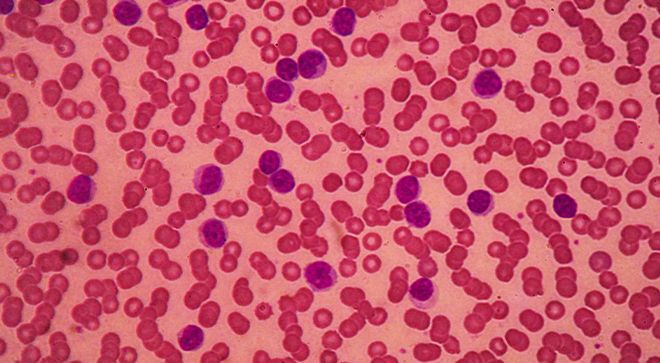Patients with treatment-naive chronic lymphocytic leukemia (CLL)/small lymphocytic lymphoma (SLL) experienced long-term improved efficacy when treated with Brukinsa (zanubrutinib) compared with bendamustine plus Rituxan (rituximab), study results have shown.
Findings from a five-year follow-up of the phase 3 SEQUOIA trial were presented at the 2024 ASH Annual Meeting.
In cohort 1 of the trial, patients who were randomly assigned to Brukinsa (241 patients) experienced improved progression-free survival (PFS) regardless of disease risk status and COVID-19 impact compared with patients randomly assigned to Rituxan (238 patients). Brukinsa also showed better overall response rate (ORR) and adverse event (AE, side effects) incidence.
Glossary
Progression-free survival: the time a patient lives without their disease spreading or worsening.
Overall response rate: patients who responded partially or completely to treatment.
Complete response: the disappearance of cancer.
Overall survival: how long a patient lives, regardless of disease status.
Neutropenia: low count of neutrophils, a type of white blood cell.
Atrial fibrillation: Irregular and often rapid heart rate, according to the Mayo Clinic.
Bruton tyrosine kinase (BTK) inhibitors offer improved outcomes for patients with CLL/SLL, and the next-generation BTK inhibitors such as Brukinsa are designed for better efficacy and tolerability through increased potency, greater BTK specificity and more exposure coverage.
“With a median study follow-up of 61.2 months, [Brukinsa] has been shown to offer a sustained superior PFS over [Rituxan] in [patients with] treatment-naive CLL with 71% reduction of the risk of progression or death,” Dr. Mazyar Shadman, medical director of cellular immunotherapy at Fred Hutchinson Cancer Center, said in his presentation of the data.
Median PFS was not reached in patients given Brukinsa versus 44.1 months in those given Rituxan. The 54- and 60-month PFS rates were 80.1% and 75.8% with Brukinsa versus 44.6% and 40.1% with Rituxan, respectively.
Additionally, the degree of PFS difference was similar when the investigators adjusted for the impact of COVID-19 on the treatment outcomes, with 83.2% versus 45.2% 54-month PFS rates and 78.7% versus 40.6% 60-month PFS rates for Brukinsa versus Rituxan, respectively.
Regardless of IGHV status, Brukinsa showed consistent PFS benefit. However, treatment with Rituxan displayed lower PFS rates which were affected by IGHV status. Shadman noted that in prior reports from cohort 2 of the SEQUIOA trial, patients with deletion 17p (del[17p]) and TP53 mutations showed similar PFS rates in those without the high-risk features. “This suggests that the treatment with [Brukinsa] may overcome negative prognostic factors such as IGHV [mutation], del(17p) or TP53 mutation,” he said.
The ORR with long-term follow-up was 97.5% with Brukinsa versus 88.7% with Rituxan. With Brukinsa, the complete response (CR)/CR with incomplete bone marrow recovery (CRi) rates was 20.7% compared with Rituxan at 23.5%. The CR/CRi rate is the highest reported with an inhibitor monotherapy, according to Shadman.
In total, 34 deaths occurred in each arm at the time of follow-up. The estimated overall survival (OS) rates at 54 and 60 months with Brukinsa were 87.7% and 85.5%, respectively; after adjusting for COVID-19, it was 91.3% and 89.4%. For treatment with Rituxan, the estimated 54- and 60-month OS rates were 86% and 85%; then with COVID-19 adjustment, 87.8% and 86.8%.
In terms of toxicity, Brukinsa was well tolerated over the extended treatment period in these patients with CLL/SLL. The most common grade 3 (severe) or higher treatment-emergent and post-treatment AEs included COVID-19 (Brukinsa, 9% versus Rituxan, 2%), hypertension (12% versus 6%) and neutropenia (10% versus 41%).
There were “low rates of atrial fibrillation/flutter [afib/flutter], infections or AEs that limit daily living activities like [gastrointestinal] toxicities,” Shadman explained.
In the original readout of the SEQUOIA trial, Brukinsa showed statistically significant and clinically meaningful improvement in PFS over Rituxan in patients with CLL/SLL without del(17p) at 26.2 months median follow-up.
Brukinsa was given at 160 milligrams twice daily until disease progression or intolerable toxicity and Rituxan was given for a maximum of six cycles. The primary end point was PFS, with ORR and CR rate as the key secondary end points. Crossover was allowed after progression and prior to starting any other therapy for CLL/SLL.
The median treatment duration with Brukinsa at the 61.2-month follow-up was 60.5 months, with 163 patients (67.6%) still receiving treatment. For Rituxan, 79% completed all six cycles of treatment and 13% discontinued early due to AEs. Fifty-nine patients overall crossed over from Rituxan to Brukinsa after experiencing disease progression.
“The result of this extended follow-up support the use of [Brukinsa] as the standard first-line treatment option for patients, regardless of the disease risk factors,” Shadman concluded.
Reference
“Sustained superiority of zanubrutinib vs bendamustine + rituximab in treatment-naive chronic lymphocytic leukemia/small lymphocytic lymphoma: 5-year follow-up of cohort 1 from the SEQUOIA study” by Dr. Mazyar Shadman et al., Blood.
For more news on cancer updates, research and education, don’t forget to subscribe to CURE®’s newsletters here.






